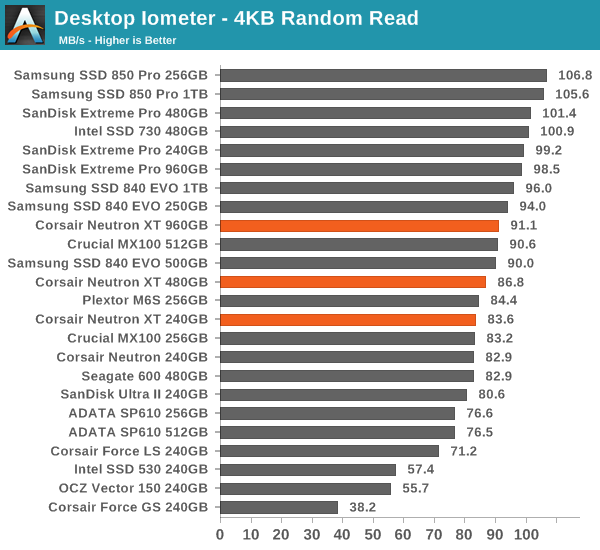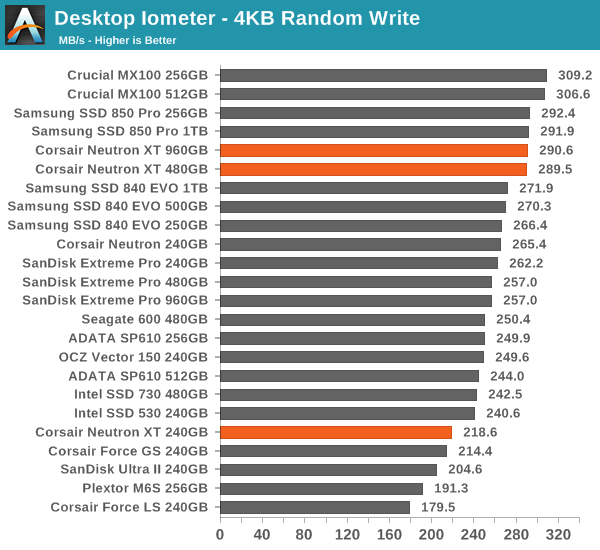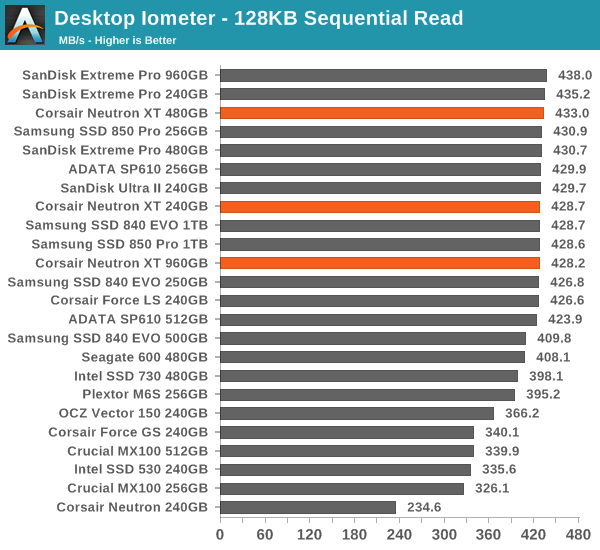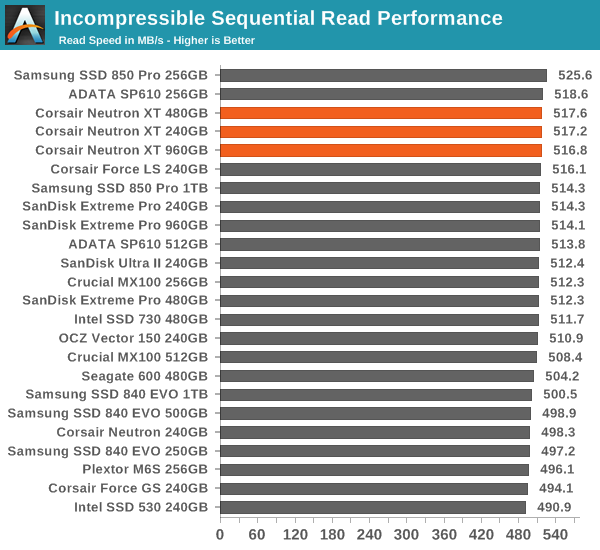Corsair Neutron XT (240GB, 480GB & 960GB) SSD Review: Phison S10 Debuts
by Kristian Vättö on November 17, 2014 9:00 AM ESTRandom Read/Write Speed
The four corners of SSD performance are as follows: random read, random write, sequential read and sequential write speed. Random accesses are generally small in size, while sequential accesses tend to be larger and thus we have the four Iometer tests we use in all of our reviews.
Our first test writes 4KB in a completely random pattern over an 8GB space of the drive to simulate the sort of random access that you'd see on an OS drive (even this is more stressful than a normal desktop user would see). We perform three concurrent IOs and run the test for 3 minutes. The results reported are in average MB/s over the entire time.

Random read speed gets a boost compared to the Force LS and the Phison finally appears to be on-par with the others.


Random write speed is also good, although the 240GB model could perform better at lower queue depths.
Sequential Read/Write Speed
To measure sequential performance we run a 1 minute long 128KB sequential test over the entire span of the drive at a queue depth of 1. The results reported are in average MB/s over the entire test length.

Here we see the performance drop when the capacity increases again. The 960GB model is quite noticeably slower in write speed compared to the rest of the capacities, although at 355MB/s it definitely isn't slow.

AS-SSD Incompressible Sequential Read/Write Performance
The AS-SSD sequential benchmark uses incompressible data for all of its transfers. The result is a pretty big reduction in sequential write speed on SandForce based controllers, but most other controllers are unaffected.












56 Comments
View All Comments
hojnikb - Tuesday, November 18, 2014 - link
So pretty much, we're gonna have to wait another year or so to get 3D nand products (ie. mx200).Chrispy_ - Tuesday, November 18, 2014 - link
Corsair *knows* you're going to test steady state.If the drive isn't good at steady state, why risk mass exposure with a bad review when a simple firmware update could make a big difference?
First impressions matter, and the Neutron XT is now an underwhelming drive unlikely to be able to compete with the MX100s on price.
ol1bit - Wednesday, November 19, 2014 - link
I'm on my 3rd SSD.1st was Intel 74GB (first one would lock up, got Intel to replace it then was good).
2nd was Corsair Force Series GT CSSD-F120GBGT-BK, and if my system got to busy, SSD would lock up HD light on solid, hard reset required, tried new drivers, everything and honestly I gave up on this drive, never fixed.
3rd is Samsung 840 pro 250GB Uber fast, no lockups ever. I'm sticking with them for the foreseeable future!
zmeul - Wednesday, November 19, 2014 - link
any word on pricing?dj christian - Thursday, November 20, 2014 - link
On the Performance Consistency page."Each of the three graphs has its own purpose. The first one is of the whole duration of the test in log scale. The second and third one zoom into the beginning of steady-state operation (t=1400s) but on different scales: the second one uses log scale for easy comparison whereas the third one uses linear scale for better visualization of differences between drives. Click the dropdown selections below each graph to switch the source data."
Which third one? All show log data and the last one doesn't show linear data.
editorsorgtfo - Saturday, November 22, 2014 - link
My A10-7850K / G.1 Sniper A88X build-in-progress is perfect for an M.2 (NGFF) SSD on a PCIe 2.0 x4 adapter card. The mobo's single PCIe 3.0 x16 slot is ripe for a Radeon R7 250, for Dual Graphics use, and its other x16 slot is PCIe 2.0, running at x4, ready for a bootable SSD to be installed.As for adapters, a Bplus M2P4A, a Lycom DT-120, or a (not-yet-released) ASUS Hyper M.2 X4 would fit the bill nicely.
The LSI SandForce SF3739-controlled cards, such as the ADATA that was shown at Computex 2013 and the Kingston seen at Storage Visions 2014 back in January, or the Kingston HyperX using the Marvell 88SS9293 Altaplus PCIe 2.0 x4 SSD Controller displayed at Computex 2014, or Phison's, or Hynix's controller-in-the-works, etc. have yet to be released to the retail market. Don't they know the world's enthusiasts are just itching to spend their dosh on those gems?!
Kingston trotted out their native PCIe expansion-slot HyperX "Predator" unit at the 2014 CES show in January, with a SF3739 controller. That's actually the unit I want! So, it's "hurry up and wait" at my house! LOL